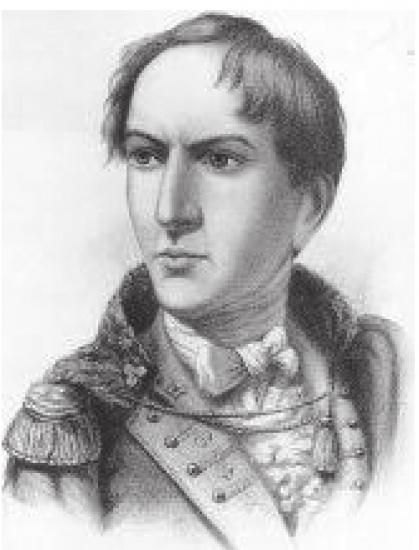Who Was Robert Emmet?
Sept. 25, 2015
Places get their names for many reasons: to describe an area’s appearance; to name it after another location; to honor a historic person from that area, like Petoskey, named after French-Ottawa Chief Ignatius Petosega or Cadillac, named after Antoine de la Mothe Cadillac, who helped found Detroit in 1701.
Sometimes, a person is honored who had absolutely nothing to do with the place like Ypsilanti, named after Demetrios Ypsilantis, a hero in the Greek War of Independence of the 1800s.
The same is true of Emmet County, named for Robert Emmet, the leader of an Irish uprising. Ed Karmann, 2015 chairman of the Robert Emmet Society of Petoskey, has the scoop on Robert Emmet and how he became an intrinsic part of the northwesternmost county of Michigan’s lower peninsula – although he never even set foot there.
HE WAS AN ABSENTEE NAMESAKE

"In 1837, Michigan was admitted to the Union," Karmann said. "At that time, the lower portion of the state was mapped out, but a good portion of the northern lower and upper portion were not."
In 1840, Karmann continued, Henry Schoolcraft, a geographer and ethnologist, was hired by the state to survey those areas. As he did so, he created names for them, including one with his own last name.
Originally, Emmet County was called Tonedagana.
"This was after a local Odawa chief from the Cross Village area," Karmann said.
In 1843, to reflect the changing population of the state, several Michigan counties were renamed.
"Wexford, Roscommon, Clare and Antrim counties were named after actual counties in Ireland," Karmann said. "The fifth was Emmet, after Robert Emmet, but other than a one-time large population of Irish immigrants hoping to honor a hero of their homeland, Emmet had no relationship to the state."
HIS FAMILY WAS KIND OF A BIG DEAL
Born in 1778, Robert Emmet came from a politically connected, wealthy, well-established family in Dublin, Ireland.
The youngest son of Dr. Robert Emmet and his wife Elizabeth, he was described as a slight man with a high forehead, expressive eyes, a sharp thin nose and a pale complexion.
"His father was the court physician to the British rulers in Ireland," Karmann said. "At 15, he was accepted to the top university in Ireland, Trinity College, and quickly rose to the top of his class."
The Emmets had two houses, one a country house. It’s likely there was a lot of spirited conversation in this educated household, as by 1797 the younger Emmet had joined the College Historical Society, a debating club.
HE MADE A STAND FOR VOTING RIGHTS
In spite of their fortunate lifestyle, Emmet and his family were well aware of the injustices in Ireland if you were not a member of the favored religion or political party.
"You were denied voting rights or representation in government," Karmann explained.
"You had almost no ability to own land or a business. You were persecuted for your religion or for speaking your native language (Gaelic) in public, and you were denied all but the most menial employment."
Those that did manage some sort of career were never allowed to advance very far. The Emmets were aware of all this and some of them tried to affect change.
HE LED THE IRISH REBELLION OF 1803
Emmet’s brother Thomas became politically active in college and Emmet himself became secretary of a secret United Irish Committee in college, which resulted in his 1798 expulsion.
He fled to France to avoid arrest, consulting with Napoleon (to little effect), and eventually returning to Ireland to prepare for an uprising.
Along with fellow revolutionaries Thomas Russell and James Hope, he began to manufacture weapons and explosives.
Word leaked about his plans after one of the explosives malfunctioned, so the uprising was bumped up to an earlier time, the evening of July 23, 1803.
Their plan was to seize a few strategic positions in the city of Dublin, then wait for others to rebel. One of their symbolic targets was Dublin Castle, which they were unable to overpower. Ultimately, the entire thing failed, ending in a large-scale, violent scuffle with more than 70 dead and many injured.
HE GAVE UP HIS OWN SAFETY FOR LOVE
After that disastrous night, Emmet had ample opportunity to escape Ireland, but he hesitated.
"His older brother Thomas had escaped to the newly created United States, but concern for members of his group kept him [Robert] in Ireland," explained Karmann.
The biggest concern was Emmet’s fiancée, Sarah Curran. Emmet was worried that British authorities would harm her, as they had his assistant, Anne Devlin, who had reportedly been tortured in an effort to obtain information about Emmet’s whereabouts.
He could have also escaped to France, but instead returned to Ireland for Curran’s sake. He was captured on Aug. 25. Several efforts were made to procure his escape, but none of them effective.
"In the end, his staying in Ireland was his undoing," Karmann said.
BUT HIS WORDS LIVE ON
At his trial, Emmet gave his now-famous "speech from the dock," explaining and defending his actions. The speech became immediately famous, was widely reprinted and known even in the U.S., where it was said Abraham Lincoln could recite it from memory.
While his speech would inspire his fellow Irish Republicans, it did not save him.
"He was convicted [of high treason] and sentenced to death," Karmann said. "From the time he was captured, his demise was a forgone conclusion. British rule was not going to take his actions lightly."
Emmet was executed, his remains buried in several unmarked graves, the locations of which were never identified.
"At the end of Emmet’s speech, just before his execution, he said, "˜When my country takes her place among the nations of the earth, then, and not till then, let my epitaph be written,’" Karmann said. "As Ireland is still a divided country, Emmet is still waiting."
AND HIS LIKENESS SHALL RETURN
Emmet lives on locally through the nonprofit Robert Emmet Society, founded in Petoskey in 1990, with the goal of creating a fifth statue of Robert Emmet and bringing it to Emmet County. Four other statues of Emmet already existed in San Francisco, Iowa, Washington D.C. and Dublin, Ireland.
For what Karmann called "various reasons," that plan was put on the back burner for a while, as the Society focused on education; a Robert Emmet scholarship now sends qualified students for a semester of study at the Galway Mayo Institute of Technology in Ireland.
The idea of a statue of Emmet is still simmering.
"Finally, the society is back on the statue!" Karmann said. "And we are looking for funding for the purpose of having the fifth statue of Robert Emmet be in Emmet County."
For more information on the Robert Emmet Society, visit emmetsociety.org.
Trending

Springtime Jazz with NMC
Award-winning vibraphonist Jim Cooper has been playing the vibraphone for over 45 years and has performed with jazz artist... Read More >>
Dark Skies and Bright Stars
You may know Emmet County is home to Headlands International Dark Sky Park, where uninterrupted Lake Michigan shoreline is... Read More >>
Community Impact Market
No need to drive through the orange barrels this weekend: Many of your favorite businesses from Traverse City’s majo... Read More >>


